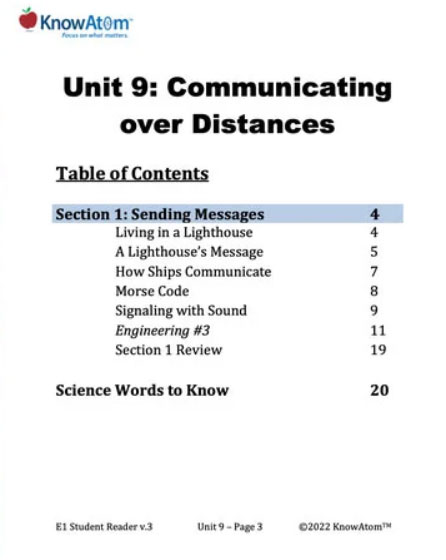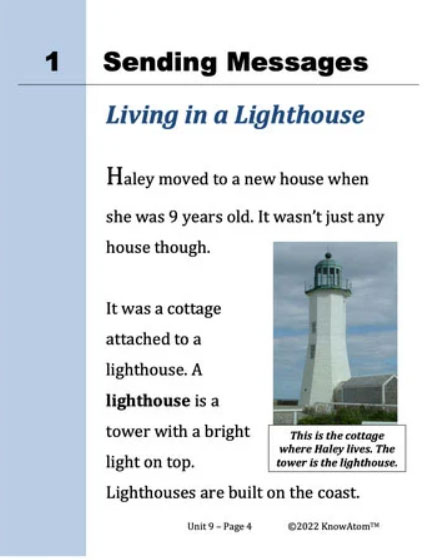In this lesson, students apply what they have learned from previous investigations into sound and light to design and build a prototype that uses sound and/or light to solve a problem that requires communicating over a distance.
In the last unit, students explore how objects can be seen when they are illuminated by a source of light and how light passes through opaque, transparent, and translucent materials differently. In this unit, students apply what they have learned about light and sound to design a solution that can be used to communicate over a distance. This page includes highlights of this lesson that has students engineer a communication device.
The science background provides teachers with more in-depth information about the science phenomena being studied in this unit.
A message is information sent from one place to another. Information is details about a person, place, or event. A signal is an action that is used to communicate information. However, on at least one occasion, the Scituate lighthouse also used sound to signal a different message.
In 1814, the lighthouse keeper was away from the lighthouse when a British warship approached, intending to send a raiding party into the town. Two daughters of the lighthouse keeper were present, and they knew they didn’t have enough time to warn the town. Instead, they began to play two instruments, a fife and a drum, which were commonly used by militias of the time. The British soldiers heard the instruments and, believing the sounds signaled the approach of the town’s militia, quickly retreated.
Technology developed in the past 200 years has led to a significant increase in the speed and reach of information. With the development of Morse code in the 1830s, people became able to send longer, more complex messages to one another over long distances. Prior to its invention, people had to handwrite messages and physically carry them from one place to another. Morse code uses short or long signals of light or sound to represent the letters of the alphabet. When it was first developed, Morse code was commonly used in telegraphs, allowing people to send messages through the sound of long and short clicks. Morse code was also useful for ships at sea to communicate with one another using large lights.
In this lesson, students apply what they have learned from previous investigations into sound and light to design and build a prototype that uses sound and/or light to solve a problem that requires communicating over a distance.

Prepared hands-on materials, full year grade-specific curriculum, and personalized live professional development designed to support mastery of current state science standards.
Information: details about a person, place, or event
Lighthouse: a tower with a bright light on top
Message: information sent from one place to another
Signal: an action that is used to communicate information
Living in a Lighthouse
Haley moved to a new house when she was 9 years old. It wasn’t just any house though. It was a cottage attached to a lighthouse. A lighthouse is a tower with a bright light on top. Lighthouses are built on the coast.
A Lighthouse’s Message
Haley’s dad is the lighthouse keeper. He makes sure the light stays lit at night. The light is important. It sends a message to sailors at sea. A message is information sent from one place to another place. Information is details about a person, place, or event.
The light is a signal that tells the sailors that they are near land. A signal is an action used to communicate information. This is important at night. The sun doesn’t shine at night. Sometimes clouds cover the moon. On a dark night, the sailors cannot see the land on their own. The lighthouse light tells the sailors they need to sail carefully.



For the engineering activity in this lesson, students summarize a problem presented in a scenario, which is that one stormy night, the electricity stopped working at Zoe’s house so Zoe couldn’t use her computer or telephone to talk to her friend across the street. Students design and build up to three prototypes of communication devices that could be used to solve Zoe’s problem, and test each one to determine how well it solved the problem, meeting the requirements of the problem within the constraints. Students collect and analyze data on whether their prototypes effectively sent a message to their partner, looking for evidence in their data about the strengths and weaknesses of each prototype.
KnowAtom incorporates formative and summative assessments designed to make students thinking visible for deeper student-centered learning.

Standards citation: NGSS Lead States. 2013. Next Generation Science Standards: For States, By States. Washington, DC: The National Academies Press. Neither WestEd nor the lead states and partners that developed the Next Generation Science Standards were involved in the production of this product, and do not endorse it.
